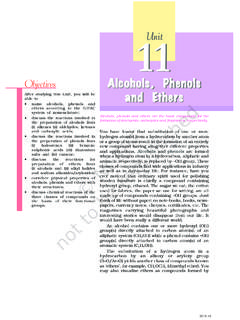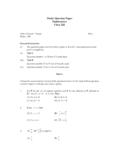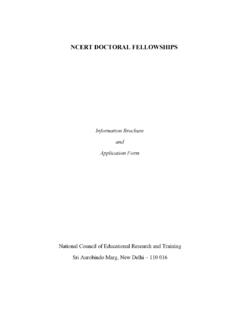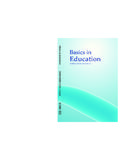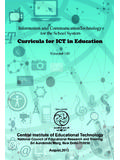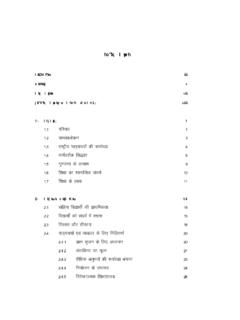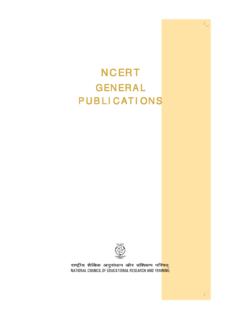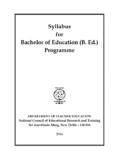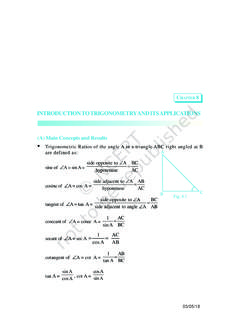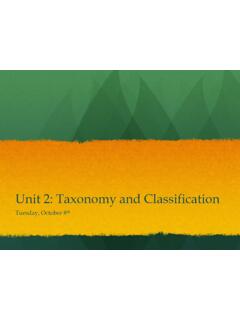Transcription of Chapter1 MMMATTER IN OUR SURROUNDINGS - NCERT
1 Chapter 1. MATTER IN OUR SURROUNDINGS . As we look at our SURROUNDINGS , we see a large Activity _____ variety of things with different shapes, sizes and textures. Everything in this universe is Take a 100 mL beaker. Fill half the beaker with water and made up of material which scientists have mark the level of water. named matter . The air we breathe, the food Dissolve some salt/ sugar with the help we eat, stones, clouds, stars, plants and of a glass rod. animals, even a small drop of water or a Observe any change in water level. particle of sand every thing is matter. We What do you think has happened to can also see as we look around that all the the salt? things mentioned above occupy space and Where does it disappear? have mass. In other words, they have both Does the level of water change? mass* and volume**. In order to answer these questions we Since early times, human beings have need to use the idea that matter is made up been trying to understand their SURROUNDINGS .
2 Of particles. What was there in the spoon, salt Early Indian philosophers classified matter in or sugar, has now spread throughout water. the form of five basic elements the This is illustrated in Fig. Panch Tatva air, earth, fire, sky and water. According to them everything, living or non- living , was made up of these five basic elements. Ancient Greek philosophers had arrived at a similar classification of matter. Modern day scientists have evolved two types of classification of matter based on their physical properties and chemical nature. In this chapter we shall learn about matter based on its physical properties. Chemical aspects of matter will be taken up in subsequent chapters. Fig. : When we dissolve salt in water, the particles of salt get into the spaces between particles Physical Nature of Matter of water. MATTER IS MADE UP OF PARTICLES. HOW SMALL ARE THESE PARTICLES.
3 For a long time, two schools of thought prevailed regarding the nature of matter. One school OF MATTER? believed matter to be continuous like a block of wood, whereas, the other thought that matter Activity _____ was made up of particles like sand. Let us T ake 2-3 crystals of potassium perform an activity to decide about the nature per manganate and dissolve them in of matter is it continuous or particulate? 100 mL of water. * The SI unit of mass is kilogram (kg). ** The SI unit of volume is cubic metre (m3). The common unit of measuring volume is litre (L) such that 1L = 1 dm3, 1L = 1000 mL, 1 mL = 1 cm3. 2015-16 Take out approximately 10 mL of this solution and put it into 90 mL of clear PARTICLES OF MATTER ARE. water. CONTINUOUSLY MOVING. Take out 10 mL of this solution and put it into another 90 mL of clear water. Keep diluting the solution like this 5 to Activity _____ 8 times.
4 Is the water still coloured ? Put an unlit incense stick in a corner of your class. How close do you have to go near it so as to get its smell? Now light the incense stick. What happens? Do you get the smell sitting at a distance? Record your observations. Activity _____ Take two glasses/beakers filled with Fig. : Estimating how small are the particles of water. matter. With every dilution, though the colour Put a drop of blue or red ink slowly becomes light, it is still visible. and carefully along the sides of the first beaker and honey in the same way in This experiment shows that just a few the second beaker. crystals of potassium permanganate can Leave them undisturbed in your house colour a large volume of water (about or in a corner of the class. 1000 L). So we conclude that there must be Record your observations. millions of tiny particles in just one crystal What do you observe immediately after of potassium permanganate, which keep on adding the ink drop?
5 Dividing themselves into smaller and smaller What do you observe immediately after particles. adding a drop of honey? The same activity can be done using How many hours or days does it take 2 mL of Dettol instead of potassium for the colour of ink to spread evenly permanganate. The smell can be detected throughout the water? even on repeated dilution. The particles of matter are very small Activity _____ they are small beyond our imagination!!!! Drop a crystal of copper sulphate or potassium permanganate into a glass Characteristics of Particles of of hot water and another containing Matter cold water. Do not stir the solution. Allow the crystals to settle at the PARTICLES OF MATTER HAVE SPACE bottom. BETWEEN THEM What do you observe just above the solid crystal in the glass? In activities and we saw that particles What happens as time passes? of sugar, salt, Dettol, or potassium What does this suggest about the permanganate got evenly distributed in water.
6 Particles of solid and liquid? Similarly, when we make tea, coffee or Does the rate of mixing change with lemonade (nimbu paani ), particles of one type temperature? Why and how? of matter get into the spaces between particles From the above three activities ( , and of the other. This shows that there is enough ), we can conclude the following: space between particles of matter. 2 SCIENCE. 2015-16 Particles of matter are continuously If we consider each student as a moving, that is, they possess what we call particle of matter, then in which group the kinetic energy. As the temperature rises, the particles held each other with the particles move faster. So, we can say that with maximum force? increase in temperature the kinetic energy of the particles also increases. Activity _____ In the above three activities we observe Take an iron nail, a piece of chalk and that particles of matter intermix on their own a rubber band.
7 With each other. They do so by getting into T ry br eaking them by hammering, the spaces between the particles. This cutting or str etching. intermixing of particles of two different types In which of the above three substances of matter on their own is called diffusion. We do you think the particles are held also observe that on heating, diffusion together with greater force? becomes faster. Why does this happen? Activity _____ PARTICLES OF MATTER ATTRACT. EACH OTHER Open a water tap, try br eaking the stream of water with your fingers. Were you able to cut the str eam of Activity _____ water? What could be the reason behind the Play this game in the field make four stream of water remaining together? groups and form human chains as suggested: The above three activities ( , and The first group should hold each ) suggest that particles of matter have force other from the back and lock arms acting between them.
8 This force keeps the like Idu-Mishmi dancers (Fig. ). particles together. The strength of this force of attraction varies from one kind of matter to another. Q. uestions 1. Which of the following are matter? Chair, air, love, smell, hate, almonds, thought, cold, cold- drink, smell of perfume. 2. Give reasons for the following Fig. observation: The smell of hot sizzling food The second group should hold hands to form a human chain. reaches you several metres The third gr oup should form a chain away, but to get the smell from by touching each other with only their cold food you have to go close. finger tips. 3. A diver is able to cut through Now, the fourth gr oup of students water in a swimming pool. Which should run around and try to break the property of matter does this three human chains one by one into observation show? as many small groups as possible. Which group was the easiest to br eak?
9 4. What are the characteristics of Why? the particles of matter? MATTER IN OUR S U R R O U N D I N G S 3. 2015-16 States of Matter the force is removed. If excessive force is applied, it breaks. Observe different types of matter around you. The shape of each individual sugar or What are its different states? We can see that salt crystal remains fixed, whether we matter around us exists in three different take it in our hand, put it in a plate or in states solid, liquid and gas. These states of a jar. matter arise due to the variation in the A sponge has minute holes, in which characteristics of the particles of matter. air is trapped, when we press it, the air Now, let us study about the properties of is expelled out and we are able to these three states of matter in detail. compress it. THE SOLID STATE THE LIQUID STATE. Activity _____ Activity _____ Collect the following articles a pen, Collect the following: a book, a needle and a piece of wooden (a) water, cooking oil, milk, juice, a stick.
10 Cold drink. Sketch the shape of the above articles (b) containers of different shapes. Put in your notebook by moving a pencil a 50 mL mark on these containers around them. using a measuring cylinder from Do all these have a definite shape, the laboratory. distinct boundaries and a fixed volume? What will happen if these liquids are What happens if they are hammered, spilt on the floor? pulled or dropped? Measure 50 mL of any one liquid and Are these capable of dif fusing into each transfer it into differ ent containers one other? by one. Does the volume remain the same? Try compr essing them by applying Does the shape of the liquid remain the force. Ar e you able to compress them? same ? All the above are examples of solids. We When you pour the liquid from one can observe that all these have a definite container into another, does it flow shape, distinct boundaries and fixed volumes, easily?
